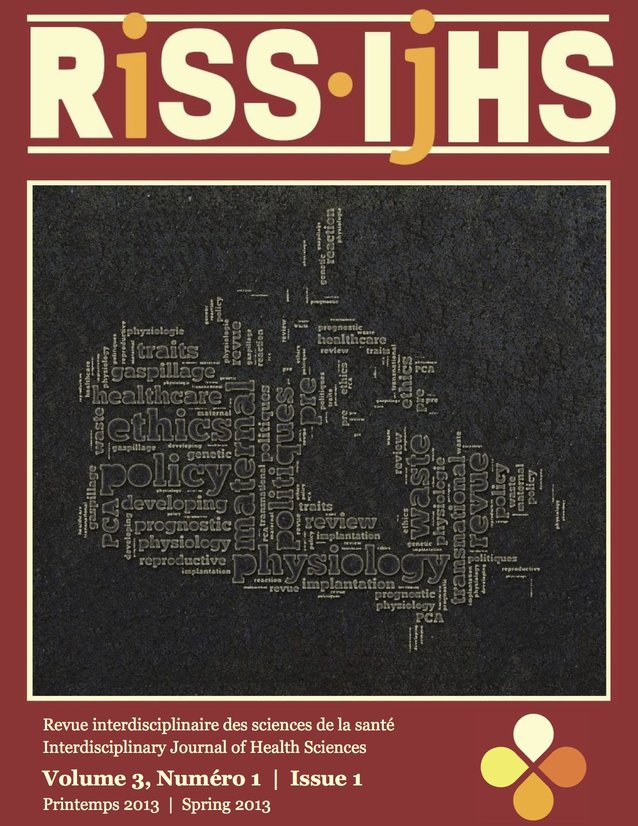The Ethics of Pre-implantation Genetic Diagnosis: An Opinion Piece Examining the Moral Distinction Between Positive and Negative Selection of Traits Using PGD
DOI :
https://doi.org/10.18192/riss-ijhs.v3i1.1451Mots-clés :
N/ARésumé
Le diagnostic préimplantatoire (DPI) suit la fécondation in vitro (FIV) de plusieurs ovules. Dans ce cadre, la sélection négative (SN), ou le rejet d’embryons contenant des allèles indésirables, est actuellement une pratique courante dans les cliniques de FIV. La sélection positive (SP), quant à elle, est le rejet d’embryons qui ne contiennent pas un allèle désirable – en d’autres termes, la SP conserve un embryon car il renferme un profil génétique souhaitable.
De nombreux groupes sont en faveur de la SN, mais il y a beaucoup moins de parti- sans de la SP. La philosophie bio-conservatrice, dirigée par des philosophes tels que Leon Kass, s’oppose à la SP et au bio-libéralisme en général. À l’inverse, la SN (et SP) d’embryons résonne mieux avec la philosophie bio-libérale, plus précisément avec un sous-ensemble du bio-libéralisme appelé le « transhumanisme ».
Pour pouvoir considérer que la SN est moralement admissible et que la SP est mora- lement inacceptable, il faut soutenir sa position en faisant une distinction entre les deux types de sélection. Les réclamations majeures contre la SP comprennent le fait que ce n’est pas médicalement grave, qu’elle répand l’eugénisme, qu’elle propage la sélection du sexe et qu’elle suscite une aversion morale qui prouve son immoralité. Dans l’analyse de ces arguments, j’espère démontrer qu’aucun d’entre eux n’est cohérent dans leur application, et que leur incapacité à être appliqués de manière universelle mine leur propre cause.
Références
Baldwin, T. (2006). Book review: The chosen child. European Molecular Biology Organization Reports, 7(7), 673. doi: 10.1038/sj.embor.7400744
Bostrom, N. (2005). A history of transhumanist thought. Journal of Evolution and Technology, 14(1), 1-30. Retrieved from http://jetpress.org/volume14/ bostrom.html
Bostrom, N., & Savulescu, J. (2008). Introduction. In N. Bostrom & J. Savulescu (Eds.), Human Enhancement (pp. 1-24). Oxford University, Oxford: Oxford University Press.
Caplan, A. L., McGee, G., & Magnus D. (1999). What is immoral about eugenics? British Medical Journal, 319, 1284-1285. Retrieved from http://dx.doi.org/10.1136/bmj.319.7220.1284
Chadwick, R., & Levitt, M. (1998). Genetic technology: A threat to deafness. Medicine, Healthcare and Philosophy, 1, 209-215. Retrieved from http://link.springer.com/ article/10.1023%2FA%3A1009960924838
Crowe, K. and Dakin, P. (2012, January 16). Selective abortions prompt call for ultrasound rules. Canadian Broadcasting Corporation News. Retrieved from www.cbc.ca
Ganatra, B. (2008). Maintaining access to safe abortion and reducing sex ratio imbalances in Asia. Reproductive Health Matters, 16(31), 90-98. doi: 10.1016/S0968-8080 (08)31394-9
Glover, J. (1984). Questions about some uses of genetic engineering. In T. Honderich (Ed.), What sort of people should there be? (pp. 25-52). Harmondsworth, UK: Penguin Books.
Glover, J. (2006). Choosing children: Genes, disability, and design. Oxford University, Oxford: Oxford University Press.
Haldane, J. B. S. (1923). Deadalus or science and the future. Cambridge, UK: E. P. Dutton and Company.
Nussbaum, M. (2004). Hiding from humanity: Disgust, shame, and the law. Princeton University, NJ: Princeton University Press.
Purdy, L. M. (1996). Genetics and reproductive risk: Can having children be immoral? Chapter 1 from Reproducing Persons: Issues in Feminist Bioethics. Ithaca, NY: Cornell University Press.
Roache, R., & Clark, S. (2009). Bioconservatism, bioliberalism, and the wisdom of reflecting on repugnance. Monash Bioethics Review, 28(1), 1-21. Retrieved from http://journals.publishing.monash.edu/ojs/ index.php/mber/article/view/571
Savulescu, J. (1999). Sex selection: The case for. Medical Journal of Australia, 171, 402- 405. Retrieved from https://www.mja.com.au/journal/1999/171/7/sex-selection-case
Sheather, J., & Shah, T. (2011). Ethical dilemmas in medical humanitarian practice: cases for reflection for Medecins Sans Frontieres. Journal of Medical Ethics, 37, 162–165. doi: 10.1136/jme.2010.038448
Singer, P. (1974). All animals are Equal. Philosophical Exchange 1(5), pp. 103-116. Retrieved here: https://iseethics.files.wordpress.com/2013/02/singer-peter-all-animals-are-equal-original.pdf
Thompson, J. J. (1971). A defense of abortion. Philosophy and Public Affairs, 1(1), 47- 66. Retrieved from http:// www.jstor.org/stable/2265091
Tooley, M. (1972). Abortion and infanticide. Philosophy and Public Affairs, 2(1), 37-65. Retrieved from http:// www.jstor.org/stable/2264919
Vallor, S. (2009). Enhancement Technologies and human
dignity: on the virtue of transformation. Proceedings of The Society for Philosophy and Technology: Converging Technologies, Changing Societies (pp. 40-41). Twente. Proceedings available at http://www.utwente.nl/gw/wijsb/archive/Archive%20activities/spt2009/programme/proceedings.pdf
Vogel, L. (2012). Sex selection migrates to Canada. Canadian Medical Association Journal, 148(3), 163-164. doi: 10.1503/cmaj.109-4091
Women in the workforce: female power (2009, December 30). 2009.The Economist. Retrieved from http:// www.economist.com/node/15174418
Téléchargements
Publié-e
Numéro
Rubrique
Licence
- Tous les auteurs dont l’article est publié dans la RISS en conserveront les droits.
- Les auteurs accordent à la RISS le droit d’être la première à publier les articles qui lui sont soumis.
- Tous les articles publiés dans la RISS sont autorisés en vertu d’une licence Creative Commons Attribution à être circulé si les auteurs et la revue de la publication originale sont reconnus.
- La RISS est publiée en ligne et imprimée. La RISS n’est pas responsable de l’utilisation non autorisée du contenu publié sous forme électronique ou imprimée.
- La RISS retient les droits de distribution de tout le contenu.
- Les auteurs, et non la RISS, sont responsables d’avoir obtenu les permissions nécessaires concernant les travaux cités.


